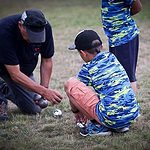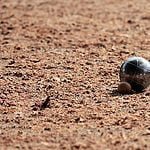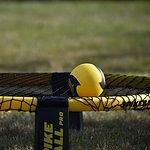You may think a bocce ball court is just a simple playing area, but it's actually a carefully constructed space where every detail matters. From the surface materials to the boundary markers, each element plays a crucial role in the game.
But have you ever wondered about the specific materials that make up a bocce ball court and why they are chosen? Let's explore the intricacies behind creating the perfect bocce ball court to enhance your playing experience.
Key Takeaways
- Bocce courts are made of oyster shell flour and decomposed granite for varying play experiences.
- Proper court layout includes sideboards, foul lines, and precise markings for enhanced gameplay.
- Site selection factors like level surface, orientation, and drainage impact court customization.
- Steel rods anchor side walls, ensuring stability, durability, and integrity for long-lasting courts.
Surface Materials for Bocce Ball Courts
When selecting surface materials for your bocce ball court, consider the impact on ball roll, maintenance, and your overall playing experience. The choice between materials like oyster shell flour and decomposed granite can significantly affect how your game unfolds.
Oyster shell flour, often used in bocce ball courts, offers a smooth and consistent playing surface. Its natural appearance blends well with outdoor settings, and its good drainage properties help prevent water buildup. The minimal dust produced by oyster shell flour makes maintenance easier compared to other materials.
On the other hand, decomposed granite, another popular option, provides a slightly different playing experience. While it may offer a coarser texture than oyster shell flour, it can still create a suitable bocce ball court surface. Ultimately, the material you choose will influence the speed, smoothness, and overall durability of your bocce ball court, impacting your game enjoyment.
Boundary Markers and Court Layout
To properly delineate the boundaries of your bocce ball court, consider using sideboards or wooden frames as boundary markers. These markers not only define the playing area but also contribute to the overall aesthetics of the court. The court layout of a bocce ball court includes foul lines at each end, dividing the court into distinct sections for gameplay. Foul lines are crucial for marking the boundaries where players must adhere to during the game to ensure fair play. By having accurately marked court boundaries, players can avoid disputes and play by the rules of bocce, enhancing the overall experience.
| Court Layout | Description |
|---|---|
| Foul Lines | Mark the court boundaries where players must stay behind. |
| Sideboards | Used as boundary markers to define the playing area. |
| Wooden Frames | Another option for boundary markers, adding a visual appeal to the court. |
| Fair Play | Ensured through proper court layout and clear boundary markers. |
Creating a well-defined court layout with clear boundary markers is essential for promoting fair play and ensuring that participants enjoy a competitive yet harmonious game of bocce.
Ideal Site Selection for Bocce Courts
For optimal bocce court performance, selecting the ideal site involves ensuring a level surface for a true ball roll, strategic orientation to avoid direct sunlight interference, good drainage to prevent water accumulation, customizable court dimensions to fit available space, and precise corner marking for layout accuracy.
When choosing a location for your bocce court, prioritize finding a flat area to eliminate any uneven ball rolls caused by sloping ground. Orienting the court north to south helps players avoid having the sun affect their gameplay. Good drainage is crucial to prevent waterlogging, ensuring the court remains playable even after heavy rain.
Customizing the court dimensions to fit the available space allows for a tailored playing experience that suits your needs. Finally, marking the court corners with stakes and twine is essential for setting up the boundaries accurately. By considering these factors during site selection, you can create the perfect bocce court for enjoyable games with friends and family.
Grading and Leveling the Court Area
Begin by clearing the vegetation and treating the area to prepare for grading and leveling the court surface for optimal bocce ball gameplay. Grading ensures a flat surface, crucial for the proper roll of bocce balls. Leveling the court area with precision is vital for an enjoyable game experience. Here's a breakdown of the steps involved in grading and leveling the court area:
| Step | Description | Importance |
|---|---|---|
| Clearing | Remove vegetation and debris from the court area | Essential |
| Grading | Ensure the surface is flat and even | Crucial |
| Crushed Stone | Use crushed stone to create a solid base | Important |
Anchoring Side Walls of the Court
Grading and leveling the court area sets the foundation for anchoring the side walls of the bocce ball court with steel rods for stability and durability. When it comes to anchoring the side walls of your bocce ball court, steel rods play a crucial role. Here's what you need to know:
- Stability: Steel rods provide a sturdy anchor for the side walls, ensuring they remain in place even during intense gameplay.
- Durability: By securely fastening the sideboards with steel rods, you enhance the overall durability of the court, making it more resistant to wear and tear.
- Preventing Shifts: Properly anchored side walls prevent any shifting or movement, maintaining the integrity of the court structure and ensuring a consistent playing surface.
Proper Surface Application Techniques
How can you ensure a smooth and level playing surface on your bocce ball court using proper surface application techniques?
To achieve this, start by spreading the surface material, such as crushed oyster shell flour, evenly across the court. Use a screed tool to level the material, ensuring consistency for gameplay. Properly compacting the material is essential to eliminate any bumps or uneven areas, resulting in a flawless playing surface.
Adding a top layer of sand or more crushed oyster shell can further enhance the court's quality, providing the ideal environment for bocce ball matches. This top layer not only improves the aesthetics but also contributes to the overall playability of the court.
Markings and Dividers on Bocce Courts
To ensure clear boundaries and fair play on your bocce ball court, precise markings and dividers are crucial elements that define the playable area and establish zones where players must adhere to specific rules.
Markings and Dividers on Bocce Courts
- Foul Lines: Foul lines are essential markings that separate the playable area from out of bounds. They help players determine the limits of the court and avoid penalties for stepping out of bounds.
- Center Lines: Center lines divide the bocce court in half, ensuring fair play for both teams. These lines help maintain symmetry on the court and provide a clear division for gameplay strategies.
- Dead Zones: Dead zones are designated areas on the court where players can't stand or throw from. These zones prevent interference with the game in progress and help maintain the integrity of the match.
Essential Bocce Court Maintenance Tips
For optimal maintenance of your bocce court, regular grooming with a 24' push broom is essential to upkeep its playability and longevity. Grooming the court helps redistribute the oyster shell surface evenly and prevents the formation of uneven patches that could affect gameplay. Occasional maintenance tasks, such as brooming, wetting, and rolling the court, are also crucial to keep the surface smooth and level.
To ensure the stability of your bocce court, make sure to secure the sideboards firmly to the ground. This prevents any movement or shifting during gameplay, maintaining the integrity of the playing area. Additionally, applying additional oyster shell flour as needed can help fill in any worn-out areas and maintain the desired playing surface texture.
For added support, consider using steel rods to anchor thick side walls securely. This extra reinforcement can prevent any structural damage and prolong the lifespan of your bocce court. By following these maintenance tips diligently, you can ensure that your bocce court remains in top condition for years to come.
Innovative Bocce Court Designs
Get ready to explore the world of bocce court design innovations that bring a new level of excitement and style to your playing experience. When it comes to enhancing your bocce court, the possibilities are endless. Here are some creative ideas to elevate your playing space:
- LED Lighting: Incorporating LED lighting into your bocce court design allows you to enjoy the game even after the sun sets. This modern touch not only adds functionality but also creates a vibrant atmosphere for nighttime play.
- Custom-Built Ball Cabinets: Keep your bocce balls organized and easily accessible with custom-built ball cabinets. These storage solutions not only declutter your space but also add a touch of sophistication to your court.
- Colorful Patterns and Landscaping Elements: Infuse personality into your bocce court by incorporating colorful patterns or logos. Additionally, integrating landscaping elements around the court enhances the overall aesthetic, blending nature seamlessly with your playing area.
Enhancing Your Bocce Playing Experience
Elevate your bocce playing experience by incorporating innovative design elements that not only enhance the aesthetics but also add functionality to your court. To enhance your bocce court, consider installing proper lighting to allow for nighttime games, extending the fun well into the evening. Building a ball cabinet from plywood can neatly store your bocce balls and accessories, keeping everything organized and easily accessible. LED string lights are recommended for illuminating the court, creating a welcoming ambiance that adds to the overall experience. Proper storage of equipment is essential for maintaining the aesthetics and functionality of your bocce ball court, ensuring everything is in its place when needed. By incorporating these elements, you can create a bocce playing space that is not only visually appealing but also highly functional.
| Enhancement | Description |
|---|---|
| Ball Size | Standard bocce balls are 107mm in diameter. |
| Build | Construct a ball cabinet from plywood for storage. |
| Need | Proper lighting, like LED string lights, is essential. |
| Crushed Oyster Shell | Ideal surface material for bocce courts. |





